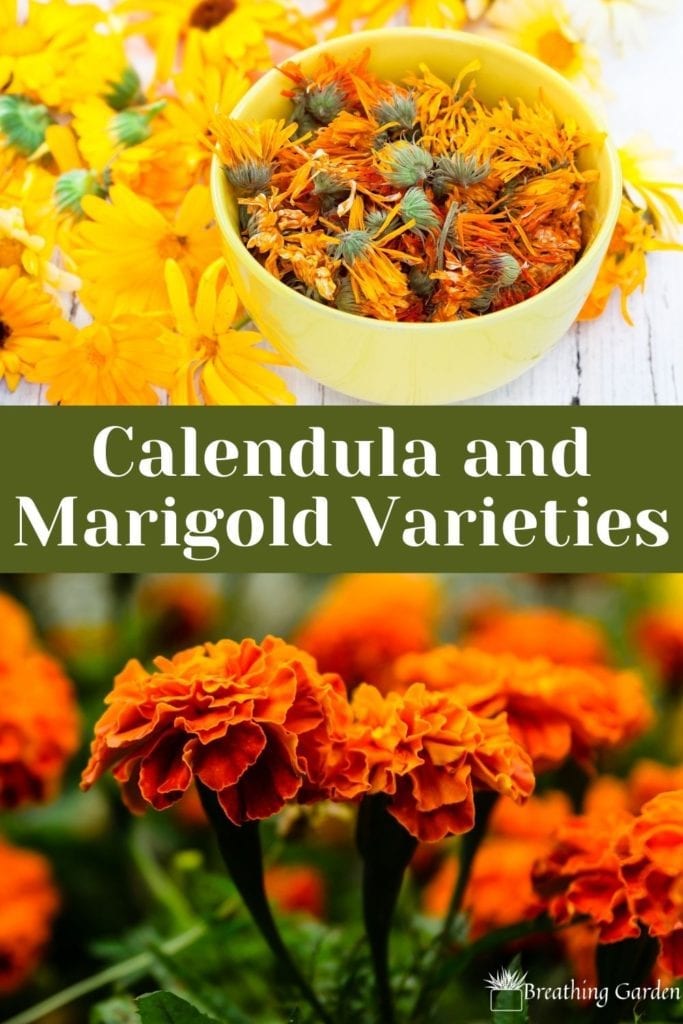Marigolds are a beautiful plant that have so many uses in the garden. There are so many different types of marigolds to grow, but these are the 4 most common varieties!
*This post may include affiliate links. When you purchase items from these links, we will receive a small commission, at no extra cost to you, to help support this website. Thank you for your support! Read more ->
A part of the daisy family, marigolds are known for their vibrant colors of red, yellow, and orange. Depending on the variety, they can be deer resistant, keep unwanted insects away, and attract ladybugs!
Some types of marigold are also edible. Here are the 4 most common varieties of marigolds to grow in your garden, and basic tips on hoq to take care of them!
Related: 5 Benefits of Marigolds in Your Vegetable Garden
French Marigolds

French marigolds are the most common type of marigold to have in your garden, especially to repel pests! This marigold flower, like many others, does have a scent makes them unattractive to many bugs.
These French marigolds are great at repelling nematodes, and are perfect companion plants for tomatoes. (Better yet, plant them a few weeks before you plant the tomatoes to kill off all of the worms before they even have a chance at the tomato.) Read more about these benefits here.
This marigold is known for being fairly short, and having multiple (smaller) blooms at once, which is how it’s distinguished from the Mexican marigold.
This type of marigold is easy to grow, and it can survive in most vegetable gardens. However, this plant does prefer full sunlight and regular watering. Try to at least give it a few hours of sunlight a day at minimum for it to survive. If it’s completely shaded over by other plant leaves, it will not make it.
Deadhead this French marigold when the flowers start wilting, so it will bloom all season long!
African Marigolds (Mexican Marigolds)

Often called African marigolds, this variety of marigold actually originates from Mexico. So it comes with a few different names: African marigold, Mexican marigold, or Aztec marigold.
These are the one of the other most common types of marigolds. They look very similar to French marigolds. The biggest way to tell the difference is the size of the flower is much larger on this, and they grow much taller, sometimes needing support for their height!
The African marigold repels many insects from the garden, and the scent also repels bigger creatures (like rabbits and deer) from eating the produce you are growing. This is another popular option to have near plants, and they will attract ladybugs.
This Mexican marigold is not edible, but it is beneficial to grow alongside produce gardens! It requires similar light and water requirements to the other, with preferring full sun.
Signet Marigold

This signet marigold is different from the French and Mexican, and is easily identifiable by the flower shape. It does not repel bugs like the first two mentioned, but is edible!
The signet marigold is another plant that repels larger animals (like deer) from eating the garden though, with it’s scent. Like the others, this marigold enjoys full sun and is an annual, surviving from the last frost to the first frost in your garden!
Add the flower of this marigold to salads for a bit of lemony, citrus flavor and a beautiful edible decoration!
You may be interested in: how often to water marigolds, how much sun do marigolds need?
Calendula (Pot Marigold)

This “marigold” is not actually one of the types of marigolds! Given the same name, likely because of the similar flower, it’s actually a calendula! This is the edible “marigold” that most people consume.
This calendula grows in very similar conditions to the marigolds mentioned above, as it doesn’t need a lot of maintenance. Grow it in fertilized, well draining soil and in full sunlight!
Remove the flowers regularly, whether to use in the kitchen or just deadhead to keep this flower blooming all summer long.
The pot marigold is the one you’ll most likely find on sandwiches, giving off a slightly spicy flavor. It also works well as a yellow food coloring substitute!
These are the most common types of marigolds to have in your garden, whether you’re looking for insect repellant, ladybug attracting, or an edible flower that’s also beautiful in your garden!
Looking for other plants in the family to grow alongside these marigolds? Try adding the colors of the rainbow with dahlias!
Pin It!
Want to keep these plant ideas for later? Save them to Pinterest!





